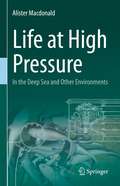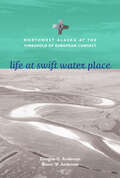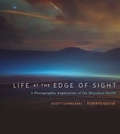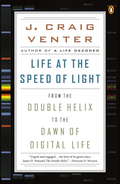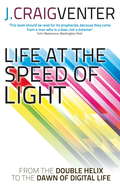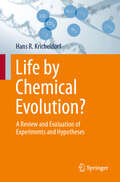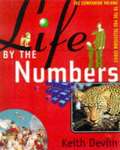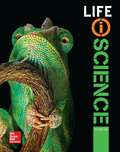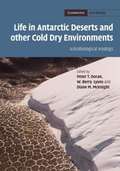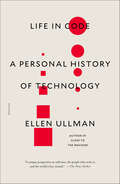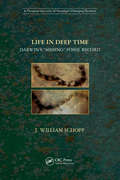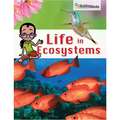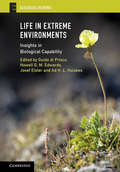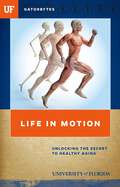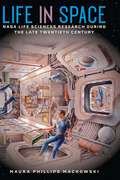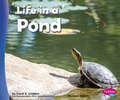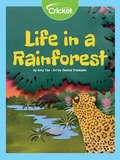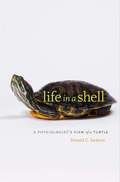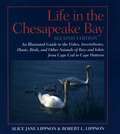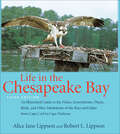- Table View
- List View
Life at High Pressure: In the Deep Sea and Other Environments
by Alister MacdonaldThe book discusses the ways in which high hydrostatic pressure (i.e. water pressure) affects all grades of life which thrive at pressures much greater those in our normal environment. The deep sea is the best known high pressure environment, where pressures reach a thousand times greater than those at the surface, yet it is populated by a variety of animals and microorganisms. The earth’s crust supports microorganisms which live in water filled pores at high pressure. In addition, the load bearing joints of animals like ourselves experience pulses of hydrostatic pressure of a magnitude similar to the pressure at mid ocean depths.These pressures affect molecular structures and biochemical reactions. Basic cellular processes are drastically affected – the growth and division of cells, the way nerves conduct impulses and the chemical reactions which provide energy. Adaptation to high pressure also occurs in complex physiological systems such as those which provide buoyancy. Probably the greatest challenge to our understanding of adaptation to high pressure is the stabilisation of the nervous system of deep sea animals to avoid convulsions which pressure causes in shallow water animals. Additionally the book provides insight into the engineering required to study life at high pressure: equipment which can trap small deep sea animals and retrieve them at their high pressure, equivalent equipment for microorganisms, laboratory microscopes which can focus on living cells under high pressure, incubators for bacteria which require high pressure to grow, high pressure aquaria for marine animals and lastly and briefly, manned and unmanned submersible vessels, Landers and deep drill hole sampling. Rather like the organisms studied many laboratory instruments have been adapted to function at high pressure.
Life at Swift Water Place: Northwest Alaska at the Threshold of European Contact
by Anderson, Douglas D.; Anderson, Wanni W.This is a multidisciplinary study of the early contact period of Alaskan Native history that follows a major hunting and fishing Inupiaq group at a time of momentous change in their lifeways. The Amilgaqtau yaagmiut were the most powerful group in the Kobuk River area. But their status was forever transformed thanks to two major factors. They faced a food shortage prompted by the decline in caribou, one of their major foods. This was also the time when European and Asian trade items were first introduced into their traditional society. The first trade items to arrive, a decade ahead of the Europeans themselves, were glass beads and pieces of metal that the Inupiat expertly incorporated into their traditional implements. This book integrates ethnohistoric, bio-anthropological, archaeological, and oral historical analyses.
Life at the Edge of Sight: A Photographic Exploration of the Microbial World
by Scott Chimileski Roberto Kolter Moselio SchaechterThis stunning photographic essay opens a new frontier for readers to explore through words and images. Microbial studies have clarified life’s origins on Earth, explained the functioning of ecosystems, and improved both crop yields and human health. Scott Chimileski and Roberto Kolter are expert guides to an invisible world waiting in plain sight.
Life at the Extremes: The Science of Survival
by Frances AshcroftThe challenge of scaling the highest mountain, exploring the deepest ocean, crossing the hottest desert, or swimming in near-freezing water is irresistible to many people. Life at the Extremes is an engrossing exploration of what happens to our bodies in these seemingly uninhabitable environments. Frances Ashcroft weaves stories of extraordinary feats of endurance with historical material and the latest scientific findings as she investigates the limits of human survival and the remarkable adaptations that enable us to withstand extreme conditions. What causes mountain sickness? How is it possible to reach the top of Everest without supplementary oxygen, when passengers in an airplane that depressurized at the same altitude would lose consciousness in seconds? Why do divers get the bends but sperm whales do not? How long you can survive immersion in freezing water? Why don't penguins get frostbite? Will men always be faster runners than women? How far into deep space can a body travel?
Life at the Speed of Light
by J. Craig VenterThe renowned scientist and author of A Life Decoded examines the creation of life in the new field of synthetic genomics.
Life at the Speed of Light: From the Double Helix to the Dawn of Digital Life
by J. Craig VenterIn 2010, scientists led by J. Craig Venter became the first to successfully create 'synthetic life' -- putting humankind at the threshold of the most important and exciting phase of biological research, one that will enable us to actually write the genetic code for designing new species to help us adapt and evolve for long-term survival. The science of synthetic genomics will have a profound impact on human existence, including chemical and energy generation, health, clean water and food production, environmental control, and possibly even our evolution.In Life at the Speed of Light, Venter presents a fascinating and authoritative study of this emerging field from the inside -- detailing its origins, current challenges and controversies, and projected effects on our lives. This scientific frontier provides an opportunity to ponder anew the age-old question 'What is life?' and examine what we really mean by 'playing God'. Life at the Speed of Light is a landmark work, written by a visionary at the dawn of a new era of biological engineering.
Life by Chemical Evolution?: A Review and Evaluation of Experiments and Hypotheses
by Hans R. KricheldorfThis book provides an in-depth analysis of the hypothesis of chemical evolution that may have led to the origin of life, serving three main purposes: it provides a comprehensive summary of hundreds of chemical experiments and analytical studies from the past 70 years, evaluates their significance in supporting the hypothesis of chemical evolution, and offers a critical review of these experiments and hypotheses. The book is particularly valuable for students, postdocs, and scientists engaged in experimental work in this field. This book outlines the latest experimental and theoretical achievements in chemical evolution research, addressing fundamental questions such as &“How to define life?&” and &“Why life by chemical evolution?&”. It explores various hypotheses and covers topics like polymerization processes, model syntheses of amino acids, saccharides, and nucleotides, and the chemistry of interstellar clouds and meteorites. In this book, readers will discover a thorough examination of the problem of homochirality and its implications for the origin of life. The book also invites readers to think through critical questions such as the likelihood of life emerging elsewhere in the universe and the role of racemization in early biochemical processes. This volume is an essential resource for researchers and scholars in biochemistry, astrobiology, and evolutionary biology, as well as students and interested laypersons. Offering valuable insights into the chemical foundations of life, this book appeals to all who are curious about how life began.
Life by the Numbers
by Keith J. DevlinThis companion to the PBS television series offers illustrated proof that mathematics is a vital and creative way of thinking and seeing, without using a single mathematical equation. Explores the range of ways in which scientists, artists, athletes, medical researchers, and others are using mathematics, and profiles present-day male and female pioneers in mathematics and science. Discussions ranging from deep-sea volcanoes to movie special effects and wearable computers are illustrated with color photos and drawings. For general readers high school and up. [This text is listed as an example that meets Common Core Standards in English language arts in grades 9-10 at http://www.corestandards.org.]
Life in Antarctic Deserts and Other Cold Dry Environments
by Peter T. Doran W. Berry Lyons Diane M. Mcknight"The McMurdo Dry Valleys form the largest relatively ice-free area on the Antarctic continent. The perennially ice-covered lakes, ephemeral streams and extensive areas of exposed soil are subject to low temperatures, limited precipitation and salt accumulation. The dry valleys thus represent a region where life approaches its environmental limits. This unique ecosystem has been studied for several decades as an analog to environments on other planets, particularly Mars. For the first time, the detailed terrestrial research of the dry valleys is brought together here, presented from an astrobiological perspective. Chapters include a discussion on the history of research in the valleys, a geological background of the valleys, setting them up as analogs for Mars, followed by chapters on the various sub-environments in the valleys such as lakes, glaciers and soils. Includes concluding chapters on biodiversity and other analog environments on Earth"--Provided by publisher.
Life in Code: A Personal History of Technology
by Ellen UllmanThe never-more-necessary return of one of our most vital and eloquent voices on technology and culture, the author of the seminal Close to the MachineThe last twenty years have brought us the rise of the internet, the development of artificial intelligence, the ubiquity of once unimaginably powerful computers, and the thorough transformation of our economy and society. Through it all, Ellen Ullman lived and worked inside that rising culture of technology, and in Life in Code she tells the continuing story of the changes it wrought with a unique, expert perspective.When Ellen Ullman moved to San Francisco in the early 1970s and went on to become a computer programmer, she was joining a small, idealistic, and almost exclusively male cadre that aspired to genuinely change the world. In 1997 Ullman wrote Close to the Machine, the now classic and still definitive account of life as a coder at the birth of what would be a sweeping technological, cultural, and financial revolution.Twenty years later, the story Ullman recounts is neither one of unbridled triumph nor a nostalgic denial of progress. It is necessarily the story of digital technology’s loss of innocence as it entered the cultural mainstream, and it is a personal reckoning with all that has changed, and so much that hasn’t. Life in Code is an essential text toward our understanding of the last twenty years—and the next twenty.
Life in Deep Time: Darwin’s “Missing” Fossil Record
by J. William SchopfWhen Darwin wrote his Origin of Species, one of his main concerns was with the perceived shortness of the fossil record of life. Until the work of J. William Schopf and his colleagues, much of this history was thought to be unknowable. This book, through a memoire of Schopf’s personal recollections, documents astonishing discoveries revealing the first 85% of the history of life. These earliest periods of life on Earth emerge as a tale of individual and internationally collaborative exploration told by a scholar whose 60 years of research contributed to the recognition of the richness and diversity which forms the foundation of today’s biodiversity. Key Features Documents, through personal narrative, a paradigm shift is the study of the earliest life Summarizes a fossil record largely unknown until relatively recently Addresses one of Darwin's most troubling concerns about his theory of natural selection Predicts future developments in the study of first life
Life in Ecosystems
by Linda CernakNIMAC-sourced textbook <p><p> Life in Ecosystems introduces students to the diversity of living organisms
Life in Ecosystems
by Linda CernakEcosystems and Habitats, Adaptations: Behavior and Physical, Science and Engineering Practices, Careers.
Life in Extreme Environments: Insights in Biological Capability (Ecological Reviews)
by Guido Di Prisco Edwards, Howell G.M. Josef Elster Huiskes, Ad H.L.From deep ocean trenches and the geographical poles to outer space, organisms can be found living in remarkably extreme conditions. This book provides a captivating account of these systems and their extraordinary inhabitants, 'extremophiles'. A diverse, multidisciplinary group of experts discuss responses and adaptations to change; biodiversity, bioenergetic processes, and biotic and abiotic interactions; polar environments; and life and habitability, including searching for biosignatures in the extraterrestrial environment. The editors emphasize that understanding these systems is important for increasing our knowledge and utilizing their potential, but this remains an understudied area. Given the threat to these environments and their biota caused by climate change and human impact, this timely book also addresses the urgency to document these systems. It will help graduate students and researchers in conservation, marine biology, evolutionary biology, environmental change and astrobiology better understand how life exists in these environments and their susceptibility or resilience to change.
Life in Motion: Unlocking the Secret to Healthy Aging
by University of FloridaThe University of Florida has an ambitious goal: to harness the power of its faculty, staff, students, and alumni to solve some of society’s most pressing problems and to become a resource for the state of Florida, the nation, and the world. In the upcoming decades, an unprecedented demographic shift will take place; the eighty-five and over population is projected to climb far higher than any other age group. To keep the current elderly population healthy and help prevent future generations from experiencing poor health outcomes, researchers are studying crucial connections between skeletal muscles and whole-body health. The University of Florida is at the forefront of this research, utilizing its nationally recognized excellence in the fields of muscle biology and exercise physiology to discover unique ways to preserve muscle health in the aging and those with diseases. Find out how the proteins within muscle can be manipulated to reduce recovery times for individuals who are bedridden. Learn how older, elite athletes have resisted the inevitable degeneration that comes with aging, and how intermittent fasting may help you live longer and healthier. Step inside the lab where a researcher is uncovering the origins of cancer cachexia—a wasting syndrome responsible for 20 percent of cancer deaths worldwide—to improve the lives of patients. The loss of skeletal muscle through disease, disuse, or aging is associated with a host of poor health outcomes, but promising new avenues of research are being studied every day at the University of Florida to make for a healthier tomorrow. The stories chronicled in GATORBYTES span all colleges and units across the UF campus. They detail the far-reaching impact of UF’s research, technologies, and innovations—and the UF faculty members dedicated to them. Gatorbytes describe how UF is continuing to build on its strengths and extend the reach of its efforts so that it can help even more people in even more places.
Life in Space: NASA Life Sciences Research during the Late Twentieth Century
by Maura Phillips MackowskiA little-known yet critical part of NASA history Life in Space explores the many aspects and outcomes of NASA’s research in life sciences, a little-understood endeavor that has often been overlooked in histories of the space agency. Maura Mackowski details NASA’s work in this field from spectacular promises made during the Reagan era to the major new directions set by George W. Bush’s Vision for Space Exploration in the early twenty-first century. At the first flight of NASA’s space shuttle in 1981, hopes ran high for the shuttle program to achieve its potential of regularly transporting humans, cargo, and scientific experiments between Earth and the International Space Station. Mackowski describes different programs, projects, and policies initiated across NASA centers and headquarters in the following decades to advance research into human safety and habitation, plant and animal biology, and commercial biomaterials. Mackowski illuminates these ventures in fascinating detail by drawing on rare archival sources, oral histories, interviews, and site visits. While highlighting significant achievements and innovations such as space radiation research and the Neurolab Spacelab Mission, Mackowski reveals frustrations—lost opportunities, stagnation, and dead ends—stemming from frequent changes in presidential administrations and policies. For today’s dreams of lunar outposts or long-term spaceflight to become reality, Mackowski argues, a robust program in space life sciences is essential, and the history in this book offers lessons to help prevent leaving more expectations unfulfilled.
Life in a Bucket of Soil (Dover Children's Science Books)
by Alvin Silverstein Virginia SilversteinThe soil in forests, meadows, and fields — even in vacant city lots or your own backyard — swarms with countless tiny creatures, most of which are born, struggle for life, and die just beneath the earth’s surface. In fact, you can find a bountiful sampling of these underground inhabitants simply by filling a bucket with soil. The small animals you’re likely to find are vividly described in this fascinating, easy-to-read book, specially designed to acquaint you with a vast, living world beneath your feet.You’ll learn about tunnel-building earthworms; threadlike, wriggly roundworms; snails and slugs (the “slime gliders”); armored scavengers such as wood lice and centipedes; “flying tanks,” more commonly known as beetles; lurking hunters such as spiders; the busy underground colonies of ants; and numerous other inhabitants of the soil. You’ll find out how these diminutive animals live, breed, and interact; learn about their methods of locomotion, feeding, and defense; and even discover how they affect the soil in which they live. The authors also provide helpful suggestions for collecting specimens and explain how they can be preserved and studied.Illustrated with more than 70 detailed black-and-white drawings, this fact-filled book will introduce you to an amazing subterranean world most people never even think about. It is sure to appeal to young naturalists, junior biologist, insect lovers, and anyone curious about the natural world.
Life in a Rainforest
by Amy TaoDo you know how many animals live in the Amazonian rainforest? Learn about the different predators and prey that coexist and depend on one another to survive in their ecosystem.
Life in a Shell: A Physiologist's View of a Turtle
by Donald C. JacksonTrundling along in essentially the same form for some 220 million years, turtles have seen dinosaurs come and go, mammals emerge, and humankind expand its dominion. Is it any wonder the persistent reptile bested the hare? In this engaging book physiologist Donald Jackson shares a lifetime of observation of this curious creature, allowing us a look under the shell of an animal at once so familiar and so strange. Here we discover how the turtle’s proverbial slowness helps it survive a long, cold winter under ice. How the shell not only serves as a protective home but also influences such essential functions as buoyancy control, breathing, and surviving remarkably long periods without oxygen, and how many other physiological features help define this unique animal. Jackson offers insight into what exactly it’s like to live inside a shell—to carry the heavy carapace on land and in water, to breathe without an expandable ribcage, to have sex with all that body armor intervening. Along the way we also learn something about the process of scientific discovery—how the answer to one question leads to new questions, how a chance observation can change the direction of study, and above all how new research always builds on the previous work of others. A clear and informative exposition of physiological concepts using the turtle as a model organism, the book is as interesting for what it tells us about scientific investigation as it is for its deep and detailed understanding of how the enduring turtle “works.”
Life in the Chesapeake Bay
by Alice Jane Lippson Robert L. LippsonPublished in 1984, the first edition of Life in the Chesapeake Bay became an instant classic, providing fascinating insights into some of the more than two thousand plants and animals that make their home in America's largest estuary, the Chesapeake Bay. Superbly illustrated and clearly written, this acclaimed field guide described the richly varied habitats found along the mid-Atlantic coast and cataloged more than three hundred species of fish, invertebrates, and aquatic plants commonly found in the Chesapeake Bay and in coastal inlets from Cape Hatteras to Cape Cod. Reflecting a further decade of research, this new edition expands on the Lippsons' discussion of wetland habitats and covers an additional 116 species closely associated with the Chesapeake Bay, including a broad range of birds and several species of insects, reptiles, and mammals. Written to be useful to a variety of readers--year-round residents and summer vacationers, professional biologists and amateur scientists, conservationists and sportsmen-- Life in the Chesapeake Bay is a unique and comprehensive guide to one of this country's most important and beautiful natural resources.
Life in the Chesapeake Bay
by Alice Jane Lippson Robert L. LippsonLife in the Chesapeake Bay is the most important book ever published on America's largest estuary. Since publication of the first edition in 1984, tens of thousands of naturalists, boaters, fishermen, and conservationists have relied on the book's descriptions of the Bay's plants, animals, and diverse habitats. Superbly illustrated and clearly written, this acclaimed guide describes hundreds of plants and animals and their habitats, from diamondback terrapins to blue crabs to hornshell snails.Now in its third edition, the book has been updated with a new gallery of thirty-nine color photographs and dozens of new species descriptions and illustrations. The new edition retains the charm of an engaging classic while adding a decade of new research.This classic guide to the plants and animals of the Chesapeake Bay will appeal to a variety of readers—year-round residents and summer vacationers, professional biologists and amateur scientists, conservationists and sportsmen.
